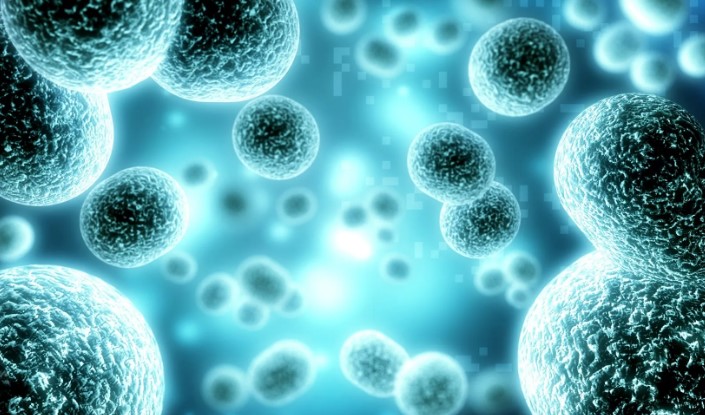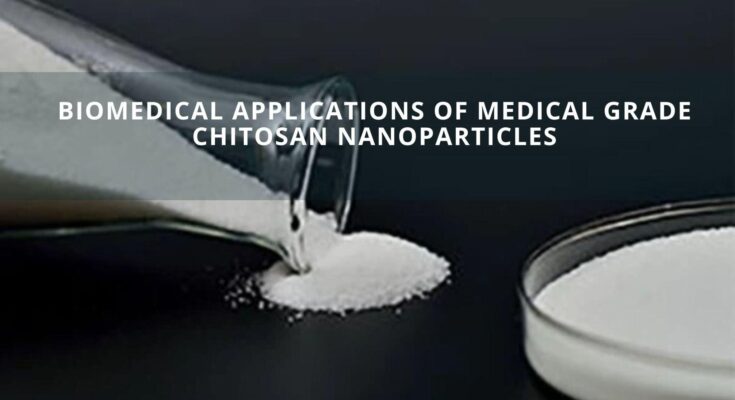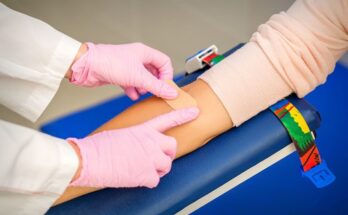Chitosan is a biocompatible and biodegradable polysaccharide derived from chitin, a naturally occurring polymer found in the shells of crustaceans. Medical-grade chitosan nanoparticles have attracted considerable attention due to their unique properties, such as their ability to form stable colloidal suspensions, biodegradability, low toxicity, and biocompatibility. Chitosan nanoparticles have shown great potential for use in various biomedical applications, including drug delivery, tissue engineering, wound healing, etc.
According to a report published by Grand View Research, the global chitosan market size was valued at $10.88 billion in 2022 and is expected to grow at a CAGR of 20.1% from 2023 to 2030. The increasing demand for chitosan in various biomedical applications is one of the key factors driving this growth. Furthermore, the COVID-19 pandemic has highlighted the need for effective and safe drug delivery systems, further increasing the demand for chitosan nanoparticles.
In this article, we will discuss the various biomedical applications of Chitosan nanoparticles.

Drug Delivery
Drug delivery is a significant application of pharma-grade chitosan nanoparticles. Chitosan nanoparticles offer several advantages over traditional drug delivery systems, such as improved drug stability, targeted delivery, and sustained drug release. The high surface area and porosity of chitosan nanoparticles make them suitable for loading and delivering a wide range of drugs, including small molecules, proteins, and nucleic acids.
- One of the most significant advantages of chitosan nanoparticles in drug delivery is their ability to cross biological barriers such as the blood-brain barrier, which is a significant challenge in drug delivery. This allows for targeted drug delivery to specific cells or tissues, such as cancer cells. Chitosan nanoparticles can be functionalized with targeting ligands such as folic acid or antibodies to target specific cells or tissues, which can enhance the effectiveness of the drug and reduce unwanted side effects.
- Sustained drug release is another advantage of chitosan nanoparticles in drug delivery. Chitosan nanoparticles can be designed to release drugs over an extended period, resulting in a more prolonged therapeutic effect. This can improve the effectiveness of the drug and reduce the frequency of administration, which can improve patient compliance.
- Chitosan nanoparticles have been studied extensively for their potential in treating various diseases, including cancer, diabetes, and Alzheimer’s disease.
- In cancer treatment, chitosan nanoparticles have been shown to enhance the efficacy of chemotherapeutic drugs by improving their solubility, stability, and targeting. Chitosan nanoparticles can also be used to deliver gene therapy, which is a promising approach for cancer treatment.
- In diabetes treatment, chitosan nanoparticles have been studied for their potential in delivering insulin. Chitosan nanoparticles can protect insulin from degradation in the stomach and enhance its absorption in the intestine, resulting in improved glycemic control.
- In Alzheimer’s disease, chitosan nanoparticles help deliver drugs to the brain, which is a significant challenge due to the blood-brain barrier. Chitosan nanoparticles can cross the blood-brain barrier and deliver drugs directly to the brain, which could revolutionize the treatment of this disease.
Tissue Engineering
Tissue engineering is a promising field that aims to regenerate damaged or diseased tissues and organs using biomaterials. Medical chitosan nanoparticles have been extensively studied for their potential in tissue engineering, as they offer several advantages, such as biocompatibility, biodegradability, and the ability to enhance cell adhesion and proliferation.
- Chitosan nanoparticles can be used as a scaffold material for tissue engineering. The nanoparticles can be incorporated into a scaffold, which acts as a template for cell growth and tissue regeneration. The scaffold provides mechanical support and also allows for nutrient and waste exchange, promoting tissue growth. Chitosan nanoparticles can be used to enhance the properties of the scaffold, such as improving mechanical strength and porosity, resulting in a more effective template for tissue regeneration.
- Chitosan nanoparticles have been used for bone regeneration by delivering bone morphogenetic protein-2 (BMP-2) to mesenchymal stem cells (MSCs). MSCs are capable of differentiating into bone cells, and BMP-2 is a growth factor that can induce bone formation. The chitosan nanoparticles act as carriers for BMP-2, protecting the growth factor from degradation and releasing it over a sustained period of time, resulting in enhanced bone formation.
- Chitosan nanoparticles have also been used as a scaffold material for skin tissue engineering, resulting in improved wound healing and skin regeneration. The nanoparticles promote cell adhesion and proliferation, and also reduce inflammation and prevent bacterial infections, which are common complications in wound healing. The chitosan nanoparticles can be incorporated into a scaffold and applied to the wound site, resulting in enhanced wound healing and skin regeneration.
- Another promising application of chitosan nanoparticles in tissue engineering is their potential to promote nerve regeneration. Chitosan nanoparticles can be functionalized with growth factors such as nerve growth factor (NGF) and delivered to the site of nerve injury. NGF can stimulate the growth and regeneration of nerves, resulting in improved nerve function.
Wound Healing
Wound healing is a complex process that can be challenging to manage, particularly in cases of chronic wounds or impaired wound healing mechanisms. Chitosan nanoparticles have been shown to accelerate wound healing by promoting cell migration, proliferation, and differentiation. Chitosan nanoparticles can also reduce inflammation and prevent bacterial infections, which are common complications in wound healing.
- The unique properties of chitosan nanoparticles make them suitable for use in wound healing applications. Chitosan is biocompatible, biodegradable, and has low toxicity, which makes it an attractive option for use in biomedical applications. Chitosan nanoparticles can also be designed to be highly porous, which allows for better absorption and retention of moisture in wounds.
- Chitosan nanoparticles have been shown to promote wound healing by accelerating the inflammatory phase of wound healing, which is essential for proper wound healing. The nanoparticles stimulate the release of growth factors and cytokines, which promote cell migration and proliferation, leading to faster wound closure. Chitosan nanoparticles can also enhance the formation of blood vessels in the wound, leading to improved tissue regeneration.
- In addition to promoting wound healing, chitosan nanoparticles can also prevent bacterial infections in wounds. Bacterial infections are a common complication in wound healing and can lead to delayed healing or even chronic wounds. Chitosan nanoparticles can inhibit the growth of bacteria in wounds by disrupting their cell membranes and preventing their proliferation.
- Chitosan nanoparticles can be used in various wound healing applications, including acute and chronic wounds, burns, and diabetic foot ulcers. In diabetic patients, wounds can be slow to heal due to impaired wound-healing mechanisms. Chitosan nanoparticles can improve wound healing in diabetic patients by promoting cell migration and proliferation, enhancing angiogenesis, and preventing bacterial infections.
Medical Imaging
Medical imaging is an essential tool for diagnosis and treatment planning for many diseases. Chitosans can be functionalized with imaging agents to improve the sensitivity and specificity of imaging modalities such as MRI and CT. They can also be used to deliver contrast agents for imaging, resulting in improved imaging contrast.
- Medical-grade chitosan nanoparticles have been studied for their potential in imaging cancer cells using iron oxide nanoparticles for MRI imaging. Iron oxide nanoparticles have been shown to improve MRI imaging of cancer cells due to their magnetic properties. By functionalizing chitosan nanoparticles with iron oxide nanoparticles, researchers can improve the sensitivity and specificity of MRI imaging for cancer diagnosis and treatment planning.
- Chitosan nanoparticles have also been used to deliver iodinated contrast agents for CT imaging, resulting in improved contrast and imaging sensitivity. Iodinated contrast agents are commonly used in CT imaging to enhance the visibility of blood vessels and tissues. By delivering iodinated contrast agents using chitosan nanoparticles, researchers can improve imaging contrast and sensitivity, resulting in more accurate diagnosis and treatment planning.
- In addition to improving imaging contrast and sensitivity, low molecular weight chitosan nanoparticles can also be used to target specific cells or tissues. By functionalizing the nanoparticles with targeting ligands, they can be designed to selectively bind to cancer cells, enabling more accurate imaging and targeted drug delivery.
Despite the promising potential of chitosan nanoparticles in medical imaging, there are still several challenges that need to be addressed. For instance, the development of more efficient and cost-effective methods for large-scale production is needed to meet the increasing demand. Additionally, further studies are needed to evaluate the long-term safety and efficacy of chitosan nanoparticles in imaging applications.
The Bottom Line
Medical-grade chitosan nanoparticles hold great promise for a wide range of biomedical applications, including drug delivery, tissue engineering, wound healing, and medical imaging. Their unique properties, such as biocompatibility, biodegradability, low toxicity, and the ability to form stable colloidal suspensions, make them an attractive option for biomedical applications.
Despite the challenges that need to be addressed, ongoing research and development in this field continue to reveal new ways in which chitosan nanoparticles can be used to improve human health. The increasing demand for chitosan in biomedical applications is expected to drive the growth of the global chitosan market in the coming years.



